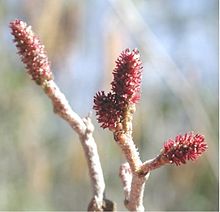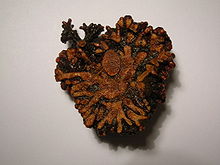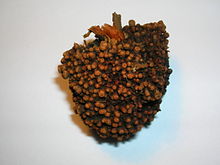Alder
| Alder | |
|---|---|

| |
| Alnus serrulata (Tag Alder) Male catkins on right, mature female catkins left Johnsonville, South Carolina | |
| Scientific classification | |
| Kingdom: | |
| Division: | |
| Class: | |
| Order: | |
| Family: | |
| Genus: | Alnus |
| Species | |
|
About 20-30 species, see text. | |
Alder is the common name of a genus of flowering plants (Alnus) belonging to the birch family (Family Betulaceae). The genus comprises about 30 species of monoecious trees and shrubs, few reaching large size, distributed throughout the North Temperate zone, and in the New World also along the Andes southwards to Argentina.
Alder leaves are deciduous (not evergreen), alternate, simple, and serrated. The flowers are catkins with elongate male catkins on the same plant as shorter female catkins, often before leaves appear; they are mainly wind-pollinated, but also visited by bees to a small extent. They differ from the birches (Betula, the other genus in the family) in that the female catkins are woody and do not disintegrate at maturity, opening to release the seeds in a similar manner to many conifer cones.
Varieties
The best-known species in Europe is the Common or Black Alder (A. glutinosa), native to most of Europe and widely introduced elsewhere. The largest species is Red Alder (A. rubra), reaching 35 m (the tallest is 32 m) on the west coast of North America, with Black Alder and Italian Alder (A. cordata) both reaching about 30 m. By contrast, the widespread Green Alder (A. viridis) is rarely more than a 5 m shrub.
Uses

Alders establish symbioses with the nitrogen-fixing Actinobacteria Frankiella alni. This bacteria converts atmospheric nitrogen into soil-soluble nitrates which can be utilised by the alder, and favorably enhances the soil fertility generally. Alders benefit other plants growing near them by taking nitrogen out of the air and depositing it in the soil in usable form; fallen alder leaves make very rich compost.
Alders are sturdy and fast-growing, even in acidic and damaged sites such as burned areas and mining sites. Italian Alder is particularly useful on dry, infertile sites. Alders can be used as a producer of simple bio-mass, growing quickly in harsh environments.
Alder catkins are one of the first sources of pollen for bee species, especially honeybees, which use it for spring buildup. Alders are also used as a food plant by some Lepidoptera (butterfly and moth) species, see list of Lepidoptera that feed on alders. Alders are also grown in gardens, and are sometimes made into bonsai.
Alder lumber is an important fast growing renewable resource used in a wide range of applications including furniture, cabinets, panel systems and special products. Alder has a fine close-grained structure and is easily stained and finished. Part of the popularity of Alder lumber is due to the unusually wide range of grades that are available. Each grade is optimized for a functional and/or economic aspect of a product, with visible surfaces, structural components and hidden parts typically using different grades. The grade spectrum, grade photos, technical definitions and an analysis of the features that make up the various grades can be found at the Alder Lumber Gradessites noted in the References and External Links section below. These sites also provide a good look at the process of optimizing Alder Lumber Productionas part of the Sustainable Forestry Initiative (SFI).
Alder is popular as a material for electric guitar bodies. It is used by many guitar makers, notably the Fender Guitar Company, who use it on top quality instruments such as the Stratocaster and Jaguar. Alder provides a brighter tone than other woods (such as mahogany), and as alder is not a particularly dense wood it provides a resonant, well-rounded tone with excellent sustain. Alder is also occasionally used to make harps, although this is a rarity.
Alder is a preferred wood for charcoal making, formerly used in the manufacture of gunpowder, or for smelting metal ores, now used primarily for cooking. The wood is also traditionally used for smoking fish and meat, though this usage has often been replaced by other woods such as oak and hickory.

An exception is the smoked Pacific salmon industry in the Pacific Northwest, where alder smoking is essentially universal. This is partly due to indigenous traditions of food preservation in the area, and partly because oak, hickory, mesquite and other woods favored for smoking elsewhere are not locally available in any large quantities. Species used for Pacific salmon smoking are Red alder A. rubra and to a lesser extent Sitka alder A. viridis ssp. sinuata.
Alders are also exceptionally good windbreakers and are planted on the west coast of Scotland to shelter gardens.[1]
In the 17th century it is recorded that in Ayrshire that alder bark was collected and used for tanning.[2]
Nitrogen fixation


Alders have root nodules which contain Frankia sps., actinomycete filamentous nitrogen-fixing bacteria. These nodules are found on the roots and may be as large as a human fist, with many small lobes and light brown in appearance.
Word origin
The common name alder is derived from an old Germanic root. Also found to be the translation of the Old French "verne" for alder or copse of alders. The botanic name Alnus is the equivalent Latin name. Both the Latin and the Germanic words derive from the Proto-Indo-European root el-, meaning "red" or "brown", which is also a root for the English words elk and another tree: elm, a tree distantly related to the alders.
Edibility and Medicinal Uses
Alder catkins are edible and high in protein. Although they are reported to have a bitter and unpleasant taste, they are best remembered for survival purposes. Alder wood is also commonly used to smoke various food items.
Alder bark contains the anti-inflammatory salicin which is metabolized into salicylic acid in the body. [3] Native Americans used Red Alder bark (Alnus rubra) to treat poison oak, insect bites, and skin irritations. Blackfeet Indians used an infusion made from the bark of Red Alder to treat lymphatic disorders and tuberculosis. Recent clinical studies have verified that red alder contains betulin and lupeol, compounds shown to be effective against a variety of tumors. [4]
Classification
The genus is divided into three subgenera:
Subgenus Alnus. Trees. Shoot buds stalked. Male and female catkins produced in autumn (fall) but staying closed over winter, pollinating in late winter or early spring. About 15-25 species, including:
- Alnus acuminata — Andean Alder. Andes Mountains, South America.
- Alnus cordata — Italian Alder. Italy.
- Alnus cremastogyne
- Alnus firma — Kyushu (Japan)
- Alnus glutinosa — Black Alder. Europe.

- Alnus incana — Grey Alder. Eurasia.
- Alnus hirsuta (A. incana subsp. hirsuta) — Manchurian Alder. Northeastern Asia, and central Asia in mountains.
- Alnus oblongifolia (A. incana subsp. oblongifolia) — Arizona Alder. Southwestern North America.
- Alnus rugosa (A. incana subsp. rugosa) — Speckled Alder. Northeastern North America.
- Alnus tenuifolia (A. incana subsp. tenuifolia) — Thinleaf or Mountain Alder. Northwestern North America.
- Alnus japonica — Japanese Alder. Japan.
- Alnus jorullensis — Mexican Alder. Mexico, Guatemala.
- Alnus mandshurica — Russian Far East, China, Korea.
- Alnus matsumurae — Honshu (Japan).
- Alnus nepalensis — Nepalese Alder. Eastern Himalaya, southwest China.
- Alnus orientalis — Oriental Alder. Southern Turkey, northwest Syria, Cyprus.
- Alnus pendula — Japan, Korea.
- Alnus rhombifolia — White Alder. Interior western North America.
- Alnus rubra — Red Alder. West coastal North America.

- Alnus serrulata — Hazel alder, Tag Alder or Smooth alder. Eastern North America.
- Alnus sieboldiana — Honshu (Japan).
- Alnus subcordata — Caucasian Alder. Caucasus, Iran.
- Alnus trabeculosa — China, Japan.
Subgenus Clethropsis. Trees or shrubs. Shoot buds stalked. Male and female catkins produced in autumn (fall) and expanding and pollinating then. Three species:
- Alnus formosana — Formosan Alder Taiwan
- Alnus maritima — Seaside Alder. East coastal North America, plus disjunct population in Oklahoma.
- Alnus nitida — Himalayan Alder. Western Himalaya.
Subgenus Alnobetula. Shrubs. Shoot buds not stalked. Male and female catkins produced in late spring (after leaves appear) and expanding and pollinating then. One to four species:
- Alnus viridis — Green Alder. Widespread:
- Alnus viridis subsp. viridis. Eurasia.
- Alnus viridis subsp. maximowiczii (A. maximowiczii). Japan.
- Alnus viridis subsp. crispa (A. crispa). Northern North America.
- Alnus viridis subsp. sinuata (A. sinuata, Sitka Alder or Slide Alder). Western North America, far northeastern Siberia.
References
- ^ Alder trees in Scotland
- ^ Corsehill Baron-Court Book. Archaeological & Historical Collections relating to the counties of Ayr and Wigton. Pub. Ayr & Wigton Arch Assoc. 1884. P. 189.
- ^ Ewing, Susan. The Great Alaska Nature Factbook. Portland: Alaska Northwest Books, 1996.
- ^ Edible and Medicinal Plants of the West, Gregory L. Tilford, ISBN 0-87842-359-1
- Chen, Zhiduan and Li, Jianhua (2004). Phylogenetics and Biogeography of Alnus (Betulaceae) Inferred from Sequences of Nuclear Ribosomal DNA ITS Region. International Journal of Plant Sciences 165: 325–335.
